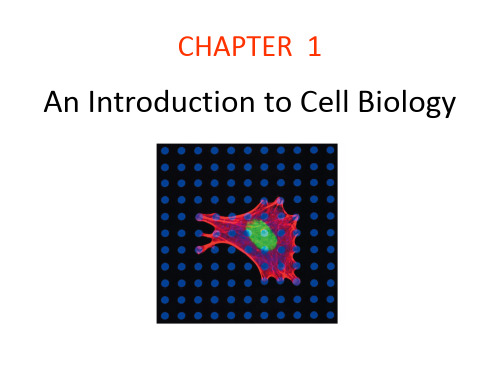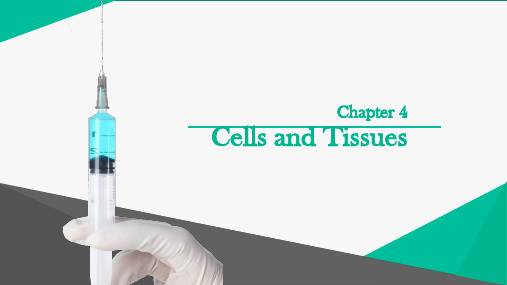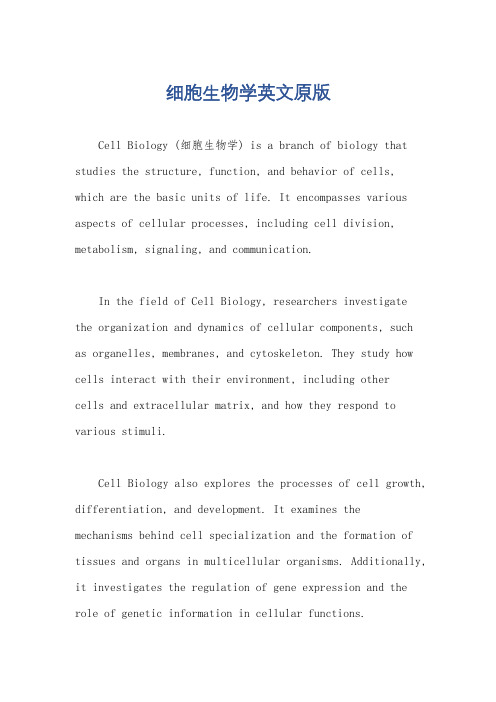chapter3 cells and tissues of the adaptive immune system
- 格式:ppt
- 大小:5.22 MB
- 文档页数:86


Inside the Living Cell: Structure andFunction of Internal Cell PartsCytoplasm: The Dynamic, Mobile Factory细胞质:动力工厂Most of the properties we associate with life are properties of the cytoplasm. Much of the mass of a cell consists of this semifluid substance, which is bounded on the outside by the plasma membrane. Organelles are suspended within it, supported by the filamentous network of the cytoskeleton. Dissolved in the cytoplasmic fluid are nutrients, ions, soluble proteins, and other materials needed for cell functioning.生命的大部分特征表现在细胞质的特征上。
细胞质大部分由半流体物质组成,并由细胞膜(原生质膜)包被。
细胞器悬浮在其中,并由丝状的细胞骨架支撑。
细胞质中溶解了大量的营养物质,离子,可溶蛋白以及维持细胞生理需求的其它物质。
The Nucleus: Information Central(细胞核:信息中心)The eukaryotic cell nucleus is the largest organelle and houses the genetic material (DNA) on chromosomes. (In prokaryotes the hereditary material is found in the nucleoid.) The nucleus also contains one or two organelles-the nucleoli-that play a role in cell division. A pore-perforated sac called the nuclear envelope separates the nucleus and its contents from the cytoplasm. Small molecules can pass through the nuclear envelope, but larger molecules such as mRNA and ribosomes must enter and exit via the pores.真核细胞的细胞核是最大的细胞器,细胞核对染色体组有保护作用(原核细胞的遗传物质存在于拟核中)。


关于细胞的英语作文Title: The Miracle of Cells.Cells, the fundamental building blocks of life, are remarkable in their simplicity and complexity. They are the smallest unit of structure and function in all organisms, from the smallest bacterium to the largest elephant. Despite their minute size, cells are incredibly dense with information and activity, containing DNA, proteins, and organelles that work together to maintain life.The structure of a cell is fascinating. It consists of a nucleus, which holds the genetic blueprint of the cell, and cytoplasm, which is the gel-like material that surrounds the nucleus and contains various organelles. Organelles are specialized structures within the cell that perform specific functions, such as mitochondria, which produce energy, and lysosomes, which break down waste materials.Cells are constantly growing, dividing, and interacting with their environment. Cell division, in particular, is a remarkable process. It involves the duplication of DNA, the partitioning of the cytoplasm, and the eventual splitting of the cell into two identical daughter cells. This process ensures the continuation of life and the maintenance of tissue and organ function.Cells are also remarkable for their adaptability. They can respond to changes in their environment, such as stress or nutrients, by altering their gene expression and metabolism. This ability to adapt allows cells to survive and thrive in a wide range of environments, from the freezing temperatures of the poles to the scorching heat of deserts.Cells are not just the building blocks of life; they are also the seat of all life's processes. From the smallest biological task, such as transporting nutrients or breaking down waste, to the most complex cognitive functions, such as thinking and feeling, cells are the engines that power these processes.The study of cells, known as cell biology, has revolutionized our understanding of life. It has allowed us to gain insights into the mechanisms of disease, develop new therapies and treatments, and even engineer cells for regenerative medicine and biotechnology.In conclusion, cells are the essence of life. They are the invisible threads that connect all living things, from the smallest microbe to the largest mammal. They are the miracle of life, constantly growing, dividing, and adapting to ensure the continuation of all life on Earth. As we continue to unravel the mysteries of cells, we gain a deeper understanding of ourselves and our place in the universe.The complexity and interconnectedness of cells are further highlighted when we consider the role of cell signaling. This is a process whereby cells communicate with each other, sending and receiving chemical signals that regulate various biological processes. Cell signaling is crucial for the coordination of cellular activities,enabling cells to respond appropriately to internal and external cues.Cells also exhibit remarkable plasticity, meaning they can change their shape, structure, and function in response to environmental cues. This plasticity is crucial for the development and maintenance of multicellular organisms, allowing cells to specialize and adapt to their specific niches within the body.The remarkable abilities of cells are further amplified when we consider the symbiotic relationships they form with other cells and organisms. For example, the human body is composed of trillions of cells, each specialized in its own way but working together to maintain homeostasis and support life. Similarly, cells within ecosystems form complex webs of interactions, with each species playing a crucial role in maintaining the health and stability of the system.In summary, cells are the building blocks of life, and their remarkable abilities and interconnections underlieall aspects of biology. The study of cells and their interactions has transformed our understanding of life, and continues to do so as new technologies and research methods are developed. As we continue to explore the mysteries of cells, we gain a deeper understanding of ourselves and our place in the universe, realizing that we are all made of these incredible building blocks of life.。

2020年6月大学英语六级阅读晨读美文:Cells andTemperatureCells cannot remain alive outside certain limits of temperature, and much narrower limits mark the boundaries of effective functioning. Enzyme systems of mammals and birdsare most efficient only within a narrow range around 37 ℃; a departure of a few degrees from this value seriously impairs their functioning. Even though cells can survive wider fluctuations, the integrated actions of bodily systems are impaired. Other animals have a wider tolerance for changes of bodily temperature. For centuries it has been recognized that mammals and birds differ from other animals in the way they regulate body temperature. Ways of characterizing the difference have become more accurate and meaningful over time, but popular terminology still reflects the old division into "warm blooded" and "cold blooded" species; warm-blooded included mammals and birds whereas all other creatures were considered cold-blooded. As more species were studied, it became evident that this classification was inadequate. Afence lizard or a desert iguana -- each cold-blooded --usually has a body temperature only a degree or two belowthat of humans and so is not cold. Therefore the next distinction was made between animals that maintain a constant body temperature, called home otherms, and those whose body temperature varies with their environment, called poikilo therms. But this classification also proved inadequate, because among mammals there are many that vary their body temperatures during hibernation. Furthermore, many invertebrates that live in the depths of the ocean neverexperience a change in the chill of the deep water, and their body temperatures remain constant.。

细胞生物学英文原版Cell Biology (细胞生物学) is a branch of biology that studies the structure, function, and behavior of cells, which are the basic units of life. It encompasses various aspects of cellular processes, including cell division, metabolism, signaling, and communication.In the field of Cell Biology, researchers investigate the organization and dynamics of cellular components, such as organelles, membranes, and cytoskeleton. They study how cells interact with their environment, including othercells and extracellular matrix, and how they respond to various stimuli.Cell Biology also explores the processes of cell growth, differentiation, and development. It examines the mechanisms behind cell specialization and the formation of tissues and organs in multicellular organisms. Additionally, it investigates the regulation of gene expression and the role of genetic information in cellular functions.Furthermore, Cell Biology plays a crucial role in understanding diseases and developing new treatments. Scientists study abnormal cell behavior and the underlying molecular mechanisms that lead to diseases like cancer, neurodegenerative disorders, and genetic disorders. This knowledge helps in the development of targeted therapies and interventions.The techniques used in Cell Biology research include microscopy, molecular biology, genetics, biochemistry, and biophysics. Microscopy allows scientists to visualize cellular structures and processes at various levels of resolution. Molecular biology techniques, such as DNA sequencing and gene editing, help in understanding the genetic basis of cellular functions. Biochemical and biophysical techniques enable the study of cellular processes at a molecular level.In summary, Cell Biology is a multidisciplinary field that investigates the structure, function, and behavior of cells. It provides insights into fundamental biologicalprocesses and has applications in various areas, including medicine, biotechnology, and agriculture. By understanding the intricacies of cell biology, scientists can unravel the mysteries of life and contribute to advancements in science and technology.。
1. According to paragraph 1, what happens to the light when a specimen is being viewed with a light microscope?A. The light continues unchanged directly into the viewer's eye or onto film.B. A glass lens bends the light to form a magnified image of the specimen.C. The light is projected onto photographic film to produce a blurred image.D. The intensity of the light increases a thousand times.Paragraph 1 is marked with ►答案:B 选项正确解析:本题根据 the light,specimen 和a light microscope 定位到第一段这几句:The first microscopes were light microscopes, which work by passing visible light through a specimen. Glass lenses in the microscope bend the light to magnify the image of the specimen and project the image into the viewer's eye or onto photographic film. 第二句讲了光学显微镜的原理,就是折射光以放大标本的图像,并且把图像投射到观察者的眼睛里或者投射到胶卷上。
选项 B 符合这句话的前半句,正确。
三年级细胞癌变英语阅读理解25题1<背景文章>Cells are very small things. We can't see them with our eyes. But they are very important. A cell is like a little house. There are different parts in a cell. The outside of a cell is called the cell membrane. It is like a wall that protects the cell. Inside the cell, there is a nucleus. The nucleus is like the boss of the cell. It tells the cell what to do. There are also other parts in the cell, like cytoplasm. Cytoplasm is like a jelly that fills the cell.1. Cells are very small and we can't see them with our ___.A. handsB. eyesC. earsD. nose答案:B。
解析:文章中明确提到“We can't see them with our eyes.”,所以答案是眼睛eyes。
2. The outside of a cell is called the ___.A. nucleusB. cytoplasmC. cell membraneD. jelly答案:C。
解析:文中提到“The outside of a cell is called the cell membrane.”,所以答案是细胞膜cell membrane。
高一细胞结构与功能英语阅读理解25题1<背景文章>The animal cell is a complex and fascinating structure. It is made up of several different parts, each with its own unique function. The cell membrane surrounds the cell and acts as a barrier, controlling what enters and leaves the cell. Inside the cell, there is the cytoplasm, a gel-like substance that contains various organelles.One of the most important organelles is the nucleus. The nucleus contains the cell's genetic material, DNA. It controls the activities of the cell and is often referred to as the control center. Another important organelle is the mitochondria. Mitochondria are responsible for producing energy in the form of ATP. They are often called the powerhouses of the cell.The endoplasmic reticulum is a network of membranes that is involved in protein synthesis and lipid metabolism. There are two types of endoplasmic reticulum: rough endoplasmic reticulum (RER) and smooth endoplasmic reticulum (SER). The RER has ribosomes attached to it and is involved in the synthesis of proteins that will be secreted from the cell or used within the cell. The SER is involved in lipid synthesis and detoxification.The Golgi apparatus is another important organelle. It modifies, sorts, and packages proteins and lipids for transport to different parts of the cell or for secretion outside the cell.In addition to these organelles, animal cells also contain lysosomes. Lysosomes are filled with digestive enzymes and are responsible for breaking down waste materials and cellular debris.Finally, animal cells also have a cytoskeleton. The cytoskeleton provides structural support for the cell and is involved in cell movement and division.Transport within the cell occurs through various mechanisms. Small molecules can diffuse through the cytoplasm. Larger molecules and organelles are transported by vesicles. Vesicles are small membrane-bound sacs that can move materials within the cell or between cells.1. What is the function of the cell membrane?A. Producing energy.B. Controlling what enters and leaves the cell.C. Synthesizing proteins.D. Storing genetic material.答案:B。